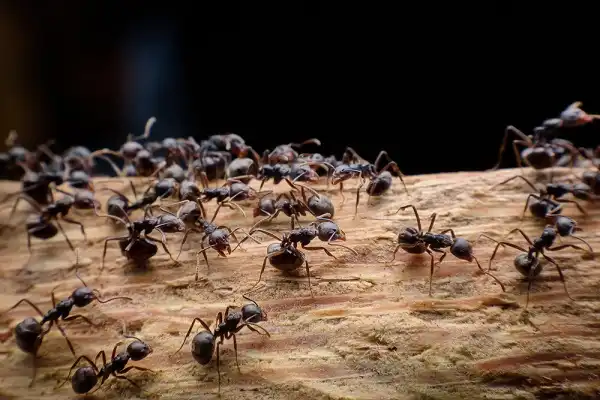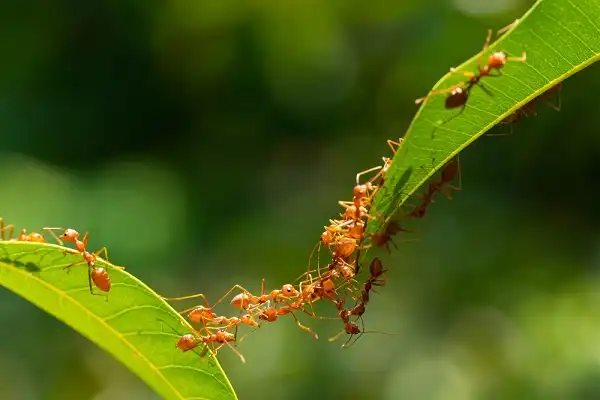If you’re like most people, you probably don’t give much thought to ants. But these fascinating creatures are actually one of the most successful groups of animals on the planet. With over 12,000 known species, they can be found in nearly every corner of the world. ants are hardworking and efficient, and they have some pretty amazing abilities. In this blog post, we’ll take a closer look at some of the things that make ants so special.

Ant Description
Ants are some of the most impressive creatures on earth. They are incredibly hardworking and resilient, able to survive in almost any climate or habitat. They come in many different sizes, shapes, and colors, and can be found living all over the world. Ants have a complex social structure within their colonies with workers and queens assigned to specific tasks. Worker ants are responsible for gathering food, constructing tunnels, tending to eggs and larvae, defending against predators, and more. Queens typically stay inside their nests and lay eggs to replenish the population. Ants communicate with each other through pheromones which allow them to coordinate activities between members of the colony. One of the remarkable abilities of ants is their capacity for collective problem-solving. They can take advantage of obstacles or resources (like food) that they encounter while searching for a path back home by forming “bridges” or pathways out of their bodies. This method is known as bridge recruiting—when a group of ants links up together to build a bridge across an obstacle or divide up food among themselves—and it’s one way they maximize their efficiency as a group.
Ant Habitat
Ants can be found in many different habitats around the world, from tropical rainforests to deserts, and even indoors. They have an incredible ability to adapt to their environment and can survive in a variety of climates and locations. Ants live primarily underground, constructing nests that include intricate tunnel systems. This helps them stay cool during hot weather and protects them from predators like birds or mice. Ant colonies are typically made up of several chambers that house eggs, larvae, pupae, workers, and queens. Each chamber serves a specific purpose within the colony and is carefully constructed using soil and other materials gathered by worker ants.
The entrance of the ant nest is often surrounded by a mound of soil which serves as protection against outside threats. The mound also acts as an early warning system for the ants as it can detect vibrations from potential predators or other disturbances. Ants are also able to recognize changes in air pressure and humidity which helps them detect danger before it arrives. Ants prefer warm climates with plenty of moisture, but they can also survive in drier environments with some modifications to their nest construction. Drought-resistant species such as harvester ants build mounds out of sand or clay in order to conserve moisture inside their nest. Some desert-dwelling ants even create underground ‘farms’ where they cultivate aphids for food!

Ant Diet
Ants have an incredibly varied diet, depending on the species and the locale. Most ants are omnivorous and feed on a combination of plant matter, insects, seeds, nectar, and fungi. Some species specialize in eating certain foods such as aphids or honeydew produced by sap-sucking insects. Worker ants often gather food for their colony by carrying pieces back to their nest. They search for food within a certain radius of their home, so they’re able to find plenty of sustenance when resources are scarce. Some ant colonies even cultivate their own ‘farms’ where they raise aphids or other pests to feed on! Ants have an amazing ability to store food for later use.
Worker ants will collect anything that is edible and carry it back to the nest where it is stored in special chambers for future meals. They can hoard large amounts of food which helps them survive long periods without rainfall or other natural disasters. The most commonly eaten foods among ants include proteins such as dead insects, larvae, eggs, and even carrion from small animals that have died nearby. Fungi are another popular source of sustenance used by many ant colonies around the world. Other items like flower nectar and honeydew are also favored among some species due to their high sugar content.
Ant Size
Ants come in a variety of sizes, and the size of an ant varies depending on its species. For example, the carpenter ant is one of the larger ant species, with workers ranging from 0.2 to 0.5 inches long and queens growing up to 1 inch in length. On the other hand, some of the smallest ants such as Pharaoh ants only measure between 0.06 to 0.1 inches long and have very narrow waists. The size of an ant also changes throughout its life cycle—and larvae are considerably smaller than adults, but they gradually increase in size as they molt until reaching their full adult size where they remain for the remainder of their lives. The number of times an ant will molt depends on its species and environmental conditions; some may molt several times while others may not molt at all! Ants are also able to adjust their body size within a few days depending on the temperature or amount of food available. This helps them survive during periods when resources are limited or when it’s too cold for them to be active outside their nest. Overall, ant size can vary greatly depending on species and environmental factors but most range between 0.06 to 1 inch long—allowing these tiny insects to thrive in a variety of habitats around the world!
Ant Lifespan
Ants have varying lifespans depending on their species and role in the colony, but most live up to 1 year or 2. The queens are generally the longest-living and, with some species living for up to 15 years! Worker ants are typically shorter-lived, ranging from a few weeks to several months depending on their activity level. In comparison, male ants usually don’t live much longer than a few weeks as they exist solely for mating purposes. The length of an ant’s life also depends on environmental factors such as temperature, humidity, food availability, and predators. Some species may be able to survive cold winter months by hibernating until warmer temperatures arrive while others might die off due to a shortage of food during lean seasons. Additionally, diseases and parasites can reduce ant lifespan considerably if left unchecked within the colony. However, some ant species have evolved special tactics that help them increase their chances of survival in harsh environments. For example, giant harvester ants will enter a state of suspended animation when resources become scarce; this allows them to remain dormant for extended periods without expending too much energy until conditions become more favorable again.

Ant Behavior
Ants are incredibly social creatures and have a wide range of behaviors that help them survive and thrive in their environment. When it comes to communication, ants rely on chemical signals or pheromones which allow them to communicate with other ants within the colony. These pheromones provide a variety of functions such as alerting other ants about food sources, warning about danger, and even attracting mates. Foraging is an important behavior for ants, as they must find food to sustain their colonies. Ants typically search for food in a systematic pattern by leaving scent trails behind them as they go. This allows other ants in the colony to easily follow the trail back to the food source.
Ant nests are also carefully designed and constructed; some species nest underground while others might build above-ground mounds or construct large tree trunk nests. These nests can be incredibly intricate thanks to the collective effort of multiple ants working together, with chambers built specifically for storing food supplies as well as areas dedicated to raising young ant larvae. When it comes to reproduction, most ant species use nuptial flights—where male ants will fly away from the colony in search of female mates. Once found, the males will mate with the females before returning home carrying fertilized eggs for incubation back at the nest.
Ant Speed
Ants are incredibly fast creatures, able to move at speeds of up to 40 centimeters per second. While this may not seem impressive compared to other animals, it should be noted that the average ant is only between two and six millimeters in length—meaning they can cover a considerable distance in an incredibly short amount of time. The speed at which ants travel depends on a variety of factors such as their size, the type of terrain they are traversing, and the weather conditions at any given time. In cold climates, for example, ants tend to move more slowly due to lower temperatures which reduces their muscle efficiency. On the other hand, in hot climates ants will work harder and faster due to higher temperatures which allow them to use more energy. Another factor that helps ants move faster is that they often work together as part of a colony; this allows for efficient movement when foraging for food or constructing nests as each ant has a specific role to play within the collective. Ants can even carry objects many times larger than themselves by working together—which is an impressive feat considering how small these insects are!
Ant Hunting
Ants are excellent hunters, taking advantage of their impressive speed, agility, and strength to capture their prey. In addition to hunting for food, ants also hunt other insects such as larvae and beetles, which they feed to their young in order to ensure their survival. Ants use a variety of strategies when hunting, depending on the species and environment. For example, some ant species may take part in cooperative hunting where several ants will work together in an organized fashion to capture much larger targets than they could individually. Other ants may work alone or act spontaneously to find food sources. In terms of what they actually hunt, many species focus on small invertebrates such as spiders or caterpillars while others prefer larger prey like lizards or even birds’ eggs! Some species of ants have even been known to attack larger animals such as snakes or mice—although this is relatively rare.

Conclusion
Ants are truly remarkable creatures, able to move quickly through their environment and hunt efficiently due to numerous physical adaptations that help them traverse obstacles and food sources with ease. They possess impressive speed as well as long legs, powerful claws, and sophisticated antennae which allow them to travel vast distances in search of potential prey while avoiding predators. Overall, ants’ impressive speed combined with clever hunting tactics makes them some of the most successful hunters in the wild!
Frequently Asked Question

